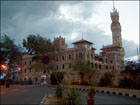|
Founded over 2,300 years ago, Alexandria has stood witness to the rise and fall of civilizations, maintaining it’s unique character and ageless charm. Today, Alexandria is Egypt’s second largest city, with a population of over 3 million, and it is the country’s main seaport. 223 kilometers from Cairo, Alexandria has a history as rich and varied as Cairo’s. Alexandria was the capital of Greco-Roman Egypt, and it remains the repository of such historical treasures as the Greco-Roman Museum, Roman Amphitheatre and Catacombs. With it’s laid back Mediterranean feel, Alexandria offers the traveler a wealth of activities. Using the newly restored Corniche (promenade along the sea coast) you are within walking distance of most of the cities sights.
Marine archaeologists have discovered a vast array of underwater artifacts and monuments in the harbor, and some will even allow you to share in the excitement by diving alongside them in this underwater museum.
|
|
|
|
 Greco- Roman Museum Greco- Roman Museum |
| |

The collection includes over 40,000 mummies, sculptures, sarcophagi, pottery, coins and tapestries from as early as the 3rd century BC.
|
|
 Alexandria National Museum Alexandria National Museum |
| |
Originally built in 1928 as an Italian Modern Style palace and then re-bought by the Supreme Council of Antiquities in 1996 with the purpose of building a world national museum exhibiting the Old history of Egypt
President Mubarak inaugurated the Museum in 2003 & it is considered to be the first of its kind built with the most updated used technology in Alexandria
The museum comprises more than 1800 archaeological pieces that narrate the Pharaonic, Greek, Roman, Coptic, Islamic and modern history of Egypt.
The Museum includes three stories. The Pharaonic monuments are exhibited in the ground floor, the Greek and Roman monuments in the first floor while the Coptic and Islamic monuments are exhibited in the upper floor.
The museum comprises an auditorium for about 150 persons and uncovered theatre for about a thousand audiences.
|
|
 Bibliotheca Alexandrina Bibliotheca Alexandrina |
| |
Above water, the newest attraction is the Bibliotheca Alexandrina. The ancient library was founded by Aristotle's pupil, Demetrius of Phalerum, in the fourth century BC. By the middle of the first century BC, the Alexandria Library contained perhaps 700,000 manuscripts on papyrus, all fully catalogued with a summary of their content and shelved alphabetically by author. Until its destruction by fire, it was the largest collection of books the world had ever seen and a pilgrimage site for enlightened scholars from all parts of the world.
In September 1988 an international competition was launched by UNESCO and the International Union of Architects to find a design that would rise to the architectural challenge of providing in one structure a functional library, an inviting public building and a monument to civilization. The winner - chosen from more than 500 entries from 77 countries - was Snohetta, an Oslo architecture and landscape firm. The design features a cylindrical building, set in a pool, with a L-shape cut out of its plan; the cylinder 's gridded glass roof stands downward until part of it disappears below ground level.
The new library is far more public than the ancient one can ever was. The Bibliotheca Alexandrina is on its way to becoming one of the world's 20 biggest national repositories of books. Its ultimate capacity is eight million volumes, and it will include science and calligraphy museums and a music library as well.
|
|
 Pompey’s Pillar Pompey’s Pillar
|
| |
This massive 25-metre-high pink granite column, which the Crusaders mistakenly credited to Pompey, rises out of the remains of the famed Serapeum, an acropolis including a temple dedicated to the Goddess Isis, and Cleopatra’s library. |
|
 Catacombs Catacombs |
| |
The Catacombs are the largest known Roman burial site in Egypt, consisting of three tiers of tombs and chambers cut into the rock to a depth of about 35 meters. Constructed in the 2nd century AD, probably as a family crypt, they were later expanded to hold more than 300 individual tombs. There is even a banquet hall where grieving relatives paid their last respects with a funeral feast.
|
|
|
| |
|

